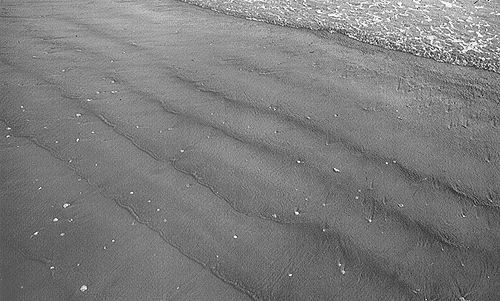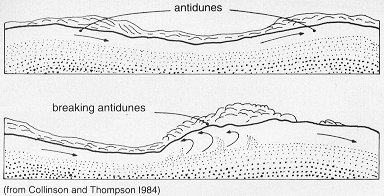

Bed forms: antidunes
Plate 37


Bed forms: antidunes
Plate 37
This structure is still mysterious as geologists do not know exactly how it fossilizes, or whether it fossilizes at all. By its nature, it is an ephemeral configuration of a sandy bottom subject to current shear. In contrast to ripples and dunes, antidunes are not observable in static but only in dynamic conditions, as exemplified by the picture. They look like broad undulations with little relief, which appear on a flat bed, stay or migrate for a while, then disappear and reappear again. In a sense, antidunes are pulsating forms, and can be produced in flumes, under controlled conditions; their formation depends on a certain combination of flow velocity and water depth. Actually, if one keeps the depth constant and increases the velocity of the current, the following sequence of events can be observed: plane sand bed, formation of ripples, formation of dunes, dune cancellation, plane bed with acarpet of moving grains, formation of antidunes, cancellation of antidunes and "pulsations" of the bed surface. For a given velocity, on the other hand, antidunes can be obtained by decreasing the water depth: as the picture shows (it was taken on a beach, when backwash was active), antidunes form under a thin veneer of water. The incoming wave thins out when climbing up the beach slope (swash), then gravity produces a return flow (backwash); in practice, we get here an oscillating current. The right combination of water velocity and depth varies within a certain range, which is known by hydraulic engineers as upper flow regime. ; A plane bed with moving grains is included in it, too. A static plane bed, ripples and subaqueous dunes are, instead, the expression of a lower flow regime. Upper and lower can be replaced by super critical and sub critical, respectively.
Besides the relief, what distinguishes antidunes from dunes is the absence of a well-pronounced slipface and of a shadow zone (boundary flow lines keep contact with the bottom), and the fact that they can be either stationary (standing antidunes) or migratory forms. When moving, they migrate upcurrent, which is the reason for their name. This means that sand is taken from the downcurrent side and deposited on the upcurrent side: in the picture, the water is flowing back to the sea, while the antidunes are moving landward.
We do not know of certain, well-documented examples of fossil antidunes: the profile of these bed forms is not preserved or, if it is, the large ratio between length and height (giving too small a relief or too great a length: the height of the examples shown here is of a few millimeters only) prevents its recognition in normal outcrop conditions. In section view, a partial preservation of antidunes is expected to show slightly inclined laminae. Low-angle lamination, however, is produced by other forms as well (hummocks, bars, etc.), and may not be considered as indicative of antidunes only. Moreover, the preservation of laminae itself is in question, because the periodic smoothing of the bed forms, preceded by breaking of water waves above them, remobilizes the sand with violence and puts it into suspension.
| Inset: modified from Collinson and Thompson 1982. |